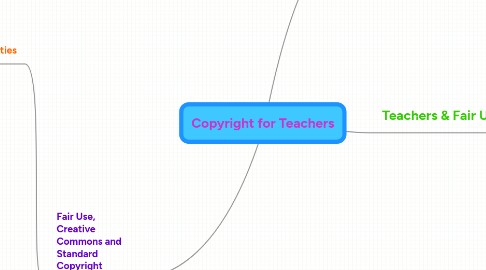
1. Fair Use, Creative Commons and Standard Copyright
1.1. Similarities
1.1.1. Protect the integrity of the creator's work
1.1.2. Limit how the material may be used by others
1.1.3. Legal protection that ensures the creator receives credit (both socially and fiscally)
1.2. Differences
1.2.1. Fair Use allows material not yet in public domain to be used depending on 4 factors
1.2.1.1. 1) Purpose and character of the copyrighted work
1.2.1.1.1. Have you transformed the original material into something new and creative?
1.2.1.1.2. Commercial vs. noncommerical purpose
1.2.1.2. 2) Nature of the copyrighted work
1.2.1.2.1. Less likely to infringe on integrity of original copyrighted material if it is factual vs. creative
1.2.1.3. 3) Amount of the copyrighted material used in the new creation
1.2.1.3.1. The acceptable amount of the original work used in the new creation varies by each case
1.2.1.4. 4) Effect on the market of the original copyrighted work
1.2.1.4.1. Will the new creation decrease the market/demand for the original?
1.2.1.5. It encourages creativity
1.2.2. Creative Commons allows the creator of the original work to create a customized copyright license
1.2.2.1. The license is free and available online
1.2.2.2. It encourages collaboration by clearly stating what the work may used for/how it may be used without the new creator having to obtain direct permission from the original creator
1.2.3. Standard Copyright automatically grants "all rights reserved" to the creator
1.2.3.1. It puts serious restrictions on the use of the material
1.2.3.2. It limits the opportunities for others to use the material for inspiration, colloboration, and transformation
1.2.3.3. This copyright lasts for life of the author plus 70 years
2. Staying Updated with Fair Use/Copyright Laws
2.1. The "Teaching Copyright" website is a great resource for information (especially the Resources page)
2.1.1. http://www.teachingcopyright.org/resources
2.2. Blogs
2.2.1. www.eff.org/deeplinks
2.2.2. www.copyfight.corante.com
2.3. Websites
2.3.1. www.copyright.gov
2.3.2. fairuse.stanford.edu
2.3.3. http://www.centerforsocialmedia.org/resources/publications/code_for_medi...
3. Teachers & Fair Use
3.1. Even if a work is still under copyright (not in public domain), Fair Use allows teachers to copy part or all of a work since it is for educational purposes
3.2. If taken to court, the 4 different factors would be analyzed to determine if it was fair use
3.3. Example: A teacher creates a PowerPoint to use in her Social Studies class which consists of copyrighted images, background music, and a video clip.
3.3.1. Since this PowerPoint is for a scholarly, non-commercial purpose, and is transformative, it passes factor 1
3.3.2. Since this PowerPoint is factual, it passes factor 2
3.3.3. Since only a clip of the video is used, this passes factor 3
3.3.4. Since this is a transformative creation (PowerPoint is a radically different format than that of the original works), the market for each individual item would not be impacted at all
